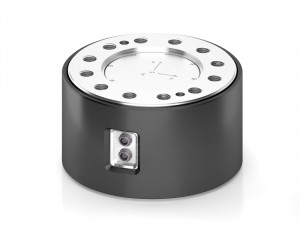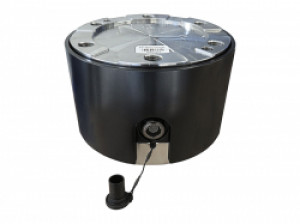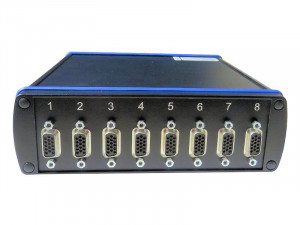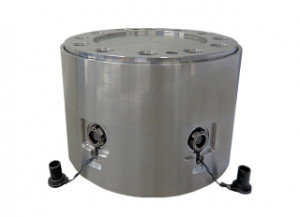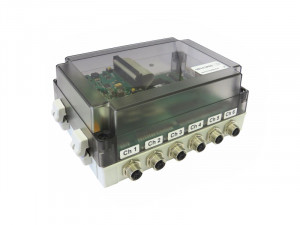6 axis force transducer - 400kN - 40 kNm - Redundant outputs
- 6-component force/torque sensor of F6D/K6D series
- Measuring ranges: 400kN/40kNm (800kN/40 kNm in Z axis)
- Calibration: tension/compression
- Accuracy class: 0.5%;
- Output signal: 0.1 mV/V
- Dimensions: Ø300 mm x 175 mm;
- Mounting and Centering: 12 x M30x1.2 threads + 2 x Ø16 mm E7 holes
- Connection: 2 UP13 connectors
- IP65 stainless steel construction
- Calibration certificate and 6x6 inter-port matrix supplied
6-component 400kN/40kNm sensor with redundant measurement
The 6-component K6D300 strain gauge force transducer simultaneously measures the forces Fx, Fy, Fz and torques Mx, My, Mz on three perpendicular axes. The measurement on each axis is performed by means of a redundant strain gage bridge, allowing:
- either to improve the accuracy by combining the two measurements, and using the 6x12 inter-channel matrix provided for this purpose. The overall accuracy is increased from 0.5% to 0.2%.
- or to have a redundant measurement chain for critical systems (double measurement, double conditioner, etc...)
Conditioning, Acquisition, Use of the decoupling matrix
The K6D300 force/torque transducer generates 12 output signals accessible via 2 rugged UP13 type connectors for 6 channels each. The redundant architecture can be used either to improve the accuracy (<= 0.2%) or to robustify the installation by using two synchronized acquisition systems GSV-8DS.
For the 1st case, a 6 x 12 decoupling matrix supplied with the sensor is used in the GSVmulti acquisition software (supplied with the sensor) to compensate for transverse effects in an optimal way, and thus obtain maximum accuracy.
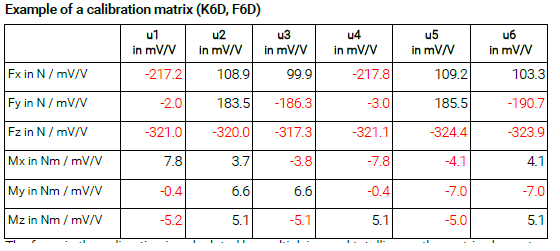
If the choice is made to use only 6 output signals from the K6D300, or to use a redundant measurement, the complete calculation of the forces, the real torques and the compensation of the transverse effects is done in the conditioner GSV-8DS before being transmitted as an analog or digital signal (serial link, CAN, EtherCAT, LAN, WifI or 3G). The origin of the reference frame in which the measured forces are projected is generally the center of the contact surface (see documentation).
Installation
The 6-component load cell K6D300 is easily installed on machine tools, arms, or test benches.
The introduction of the forces and the fixing to the bench are carried out by 12 taps M30 x 1.75 of 15mm of depth + 2 pins of contrage Ø16 mm F7 (Torques of tightenings: see here). The application of the force is made on the portions of the surface raised by 1 mm. The inner part of the surface is used for centering.
The sensor is supplied with 5 VDC. The operating temperature range is -10 to 85°C. The output signal is not amplified. The sensor is delivered with either a connector or a 5m cable.
Applications
K6D300 is recommended for robotics, aerospace and manufacturing applications.
Options and accessories
- Calibration: Standard or [specific] (https://www.pm-instrumentation.com/storage/3892/Calibration-option-Matrix-Plus.pdf), ISO-17025
- Robotic mounting kit (ISO 9409 standard)
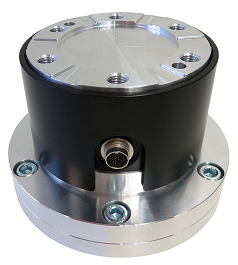
- Cable and connector for GSV
- Packaging and acquisition module GSV-8DS, GSV-8AS or GSV-6LTE
- Extended temperature compensation
- TEDS
- Type
- 6 axis sensor
- Number of Axis
- 6 Axis
- Precision (max error)
- 0.25 %, 0.5 %
- Tension d'alimentation
- 10 Vcc
- Measurement direction
- Traction & Compress.
- Housing
- Steel
- Protection Class
- IP65
- Measuring Range (Force)
- > 250 kN
- Application
- High Accuracy, Robotics
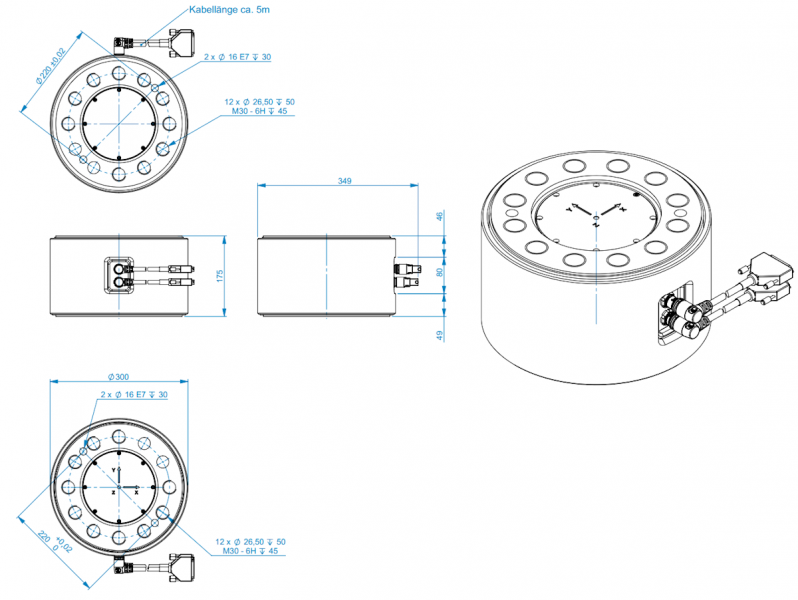
- Calibration: Standard or [specific] (https://www.pm-instrumentation.com/storage/3892/Calibration-option-Matrix-Plus.pdf), ISO-17025
- Robotic mounting kit (ISO 9409 standard)

- Cable and connector for GSV
- Packaging and acquisition module GSV-8DS, GSV-8AS or GSV-6LTE
- Extended temperature compensation
- TEDS
- Calibration: Standard or [specific] (https://www.pm-instrumentation.com/storage/3892/Calibration-option-Matrix-Plus.pdf), ISO-17025
- Robotic mounting kit (ISO 9409 standard)

- Cable and connector for GSV
- Packaging and acquisition module GSV-8DS, GSV-8AS or GSV-6LTE
- Extended temperature compensation
- TEDS

